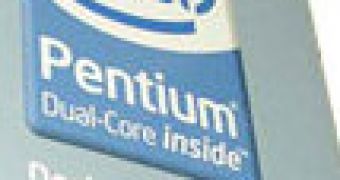A couple of years ago, Intel decided to put an end to the Pentium CPU brand. The good ol' Pentium architecture was clearly outdated and outperformed by AMD's X2 CPUs. Intel apparently killed the Pentium architecture and replaced it with the all-new Core Duo successor. We have to admit that this was a winning move for Intel, but no one really knows why the Pentium brand was so suddenly abandoned. Some of you may argue that there still are Pentium D CPUs, but who exactly buys them nowadays? The latest Intel developments show that the Pentium brand isn't that dead after all, as the company is preparing to resurrect the brand with a new budget dual-core CPU lineup.
According to current road-maps, the remaining Pentium D processors will soon be replaced by CPUs based on the Core micro-architecture. The direct descendants of the Pentium D family will not be represented by the new low-cost Core 2 Duo CPUs, but by a special dual-core processor series that will be selling under the same Pentium brand name. However, these new CPUs don't seem to have much in common with any previous Pentium processor, as they will have totally new ratings and a completely new micro-architecture. Enter the Pentium E2000 family.
So, what's the scheme behind this new Pentium release? Now, if I were an Intel market analyst, everything would be crystal clear. Everybody in the IT&C world knows about the Pentium trademark, even those users who are not following the new product launches and new technology announcements very closely. Over the years, Intel has learned that this particular group of users do not hunt for the highest performance CPUs, regarding their PCs as consumer electronics products. Logically, these users are the perfect target for Intel's new processor family under the notorious Pentium brand.
Preliminary tests have demonstrated that the Pentium E2160 and E2140 CPUs will definitely be best buy products, performing much better than the obsolete Pentium D NetBurst processors. Although having only 1MB L2 cache and running below 2 GHz, these CPUs can be easily overclocked, making them a no-brainer choice for budget users.

 14 DAY TRIAL //
14 DAY TRIAL //